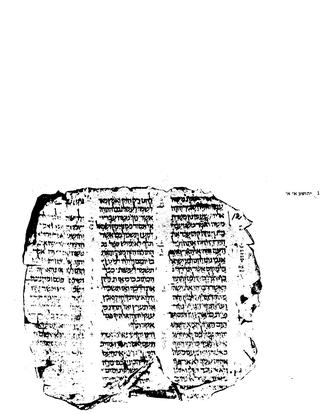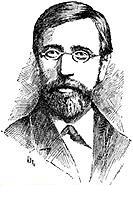Related Research Articles

The Codex Sinaiticus, designated by siglum א [Aleph] or 01, δ 2, or Sinai Bible is a fourth century Christian manuscript of a Greek Bible, containing the majority of the Greek Old Testament, including the Apocrypha along with the deuterocanonical books, and the Greek New Testament, with both the Epistle of Barnabas and the Shepherd of Hermas included. It is written in uncial letters on parchment. It is one of the four great uncial codices. Along with Codex Alexandrinus and Codex Vaticanus, it is one of the earliest and most complete manuscripts of the Bible, and contains the oldest complete copy of the New Testament. It is a historical treasure, and using the study of comparative writing styles (palaeography), it has been dated to the mid-fourth century.

The Masoretic Text is the authoritative Hebrew and Aramaic text of the 24 books of the Hebrew Bible (Tanakh) in Rabbinic Judaism. The Masoretic Text defines the Jewish canon and its precise letter-text, with its vocalization and accentuation known as the mas'sora. Referring to the Masoretic Text, masorah specifically means the diacritic markings of the text of the Jewish scriptures and the concise marginal notes in manuscripts of the Tanakh which note textual details, usually about the precise spelling of words. It was primarily copied, edited, and distributed by a group of Jews known as the Masoretes between the 7th and 10th centuries of the Common Era (CE). The oldest known complete copy, the Leningrad Codex, dates from the early 11th century CE.

The Aleppo Codex is a medieval bound manuscript of the Hebrew Bible. The codex was written in the city of Tiberias in the tenth century CE under the rule of the Abbasid Caliphate, and was endorsed for its accuracy by Maimonides. Together with the Leningrad Codex, it contains the Ben-Asher masoretic tradition.
Aaron ben Moses ben Asher was a sofer who lived in Tiberias. He perfected the Tiberian system of writing vowel sounds in Hebrew. The system is still in use today, serving as the basis for grammatical analysis.

The Leningrad Codex is the oldest complete manuscript of the Hebrew Bible in Hebrew, using the Masoretic Text and Tiberian vocalization. According to its colophon, it was made in Cairo in AD 1008.

The Uspenski Gospels, Minuscule 461, ε 92 (Soden), are a New Testament minuscule manuscript written in Greek, dated to 835 AD, and now in St Petersburg in Russia. They are the oldest known dated manuscript of the New Testament; it was not customary for Greek scribes to date their work at the time.

Christian David Ginsburg was a Polish-born British Bible scholar and a student of the Masoretic tradition in Judaism. He was born to a Jewish family in Warsaw but converted to Christianity at the age of 15.

The Codex Cairensis is a Hebrew manuscript containing the complete text of the Hebrew Bible's Nevi'im (Prophets). It has traditionally been described as "the oldest dated Hebrew Codex of the Bible which has come down to us", but modern research seems to indicate an 11th-century date rather than the 895 CE date written into its colophon. It contains the books of the Former Prophets and Latter Prophets. It comprises 575 pages including 13 carpet pages.
The Codex Zographensis is an illuminated Old Church Slavonic canon manuscript. It is composed of 304 parchment folios; the first 288 are written in Glagolitic containing Gospels and organised as Tetraevangelium, and the rest written in Cyrillic containing a 13th-century synaxarium. It is dated back to the end of the 10th or beginning of the 11th century.
Jewish printers were quick to take advantages of the printing press in publishing the Hebrew Bible. While for synagogue services written scrolls were used, the printing press was very soon called into service to provide copies of the Hebrew Bible for private use. All the editions published before the Complutensian Polyglot were edited by Jews; but afterwards, and because of the increased interest excited in the Bible by the Reformation, the work was taken up by Christian scholars and printers; and the editions published by Jews after this time were largely influenced by these Christian publications. It is not possible in the present article to enumerate all the editions, whole or partial, of the Hebrew text. This account is devoted mainly to the incunabula.

Codex Petropolitanus Purpureus, designated by N or 022, ε 19, is a Greek New Testament codex containing the four Gospels. Using the study of comparative writing styles (palaeography), it has been assigned to the 6th century CE.
The Jerusalem Crown is a printed edition of the Tanakh printed in Jerusalem in 2001, and based on a manuscript commonly known as the Aleppo Crown). The printed text consists of 874 pages of the Hebrew Bible, two pages setting forth both appearances of the Ten Commandments each showing the two different cantillations - for private and for public recitation, 23 pages briefly describing the research background and listing alternative readings, a page of the blessings - the Ashkenazic, Sefardic and Yemenite versions - used before and after reading the Haftarah, a 9-page list of the annual schedule of the Haftarot readings according to the three traditions.

Seligman (Isaac) Baer (1825–1897) was a Masoretic scholar, and an editor of the Hebrew Bible and of the Jewish liturgy. He was born in Mosbach, the northern district of Biebrich, on 18 September 1825 and died at Biebrich-on-the-Rhine in March 1897.

The Babylonian vocalization, also known as Babylonian supralinear punctuation, or Babylonian pointing or Babylonian niqqud Hebrew: נִקּוּד בָּבְלִי) is a system of diacritics (niqqud) and vowel symbols assigned above the text and devised by the Masoretes of Babylon to add to the consonantal text of the Hebrew Bible to indicate the proper pronunciation of words, reflecting the Hebrew of Babylon. The Babylonian notation is no longer in use in any Jewish community, having been supplanted by the sublinear Tiberian vocalization. However, the Babylonian pronunciation as reflected in that notation appears to be the ancestor of that used by Yemenite Jews.
Isaiah 39 is the thirty-ninth chapter of the Book of Isaiah in the Hebrew Bible or the Old Testament of the Christian Bible. This book contains the prophecies attributed to the prophet Isaiah, and is one of the Books of the Prophets. This chapter concludes the section of Isaiah attributed to Isaiah himself (Proto-Isaiah). In the New King James Version, this chapter is sub-titled "The Babylonian Envoys". Isaiah foretells the exile to Babylon of the people of Judah.

The codex Parisino-petropolitanus is one of the oldest extant manuscripts of the Quran, attributed to the 7th century.

The Damascus Pentateuch or Codex Sassoon 507 is a 10th-century Hebrew Bible codex, consisting of the almost complete Pentateuch, the Five Books of Moses. The codex was copied by an unknown scribe, replete with Masoretic annotations. The beginning of the manuscript is damaged: it starts with Genesis 9:26, and Exodus 18:1–23 is also missing. In 1975 it was acquired by the Jewish National and University Library, Jerusalem. The codex was published in a large, two-volume facsimile edition in 1978.
Isaiah 46 is the forty-sixth chapter of the Book of Isaiah in the Hebrew Bible or the Old Testament of the Christian Bible. This book contains the prophecies attributed to the prophet Isaiah, and is a part of the Books of the Prophets. Isaiah 40-55 is known as "Deutero-Isaiah" and dates from the time of the Israelites' exile in Babylon.

Codex S1 is a Masoretic codex comprising all 24 books of the Hebrew Bible, dated to the 10th century CE. It is considered as old as the Aleppo Codex and a century older than the Leningrad Codex, the earliest known complete Hebrew Bible manuscript. Alternatively, it might be dated to the late 9th century. The Aleppo Codex was missing 40% of its leaves when it resurfaced in Israel in 1958, while in Codex S1 only twelve leaves are completely missing and hundreds more are partially lost. The scribe of S1 was unusually sloppy, frequently forgetting punctuation, diacritical marks, and vowels; he also errs in his consonantal spelling on dozens of occasions.

The London Codex, or Codex Orientales 4445 is a Hebrew codex containing Masoretic text dating from the 9th or 10th century. The manuscript contains an incomplete copy of the Pentateuch. The manuscript is housed in the British Museum.
References
- 1 2 3 4 Würthwein, Ernst (1995). The Text of the Old Testament. Eerdmans. p. 37. ISBN 0-8028-0788-7.
- ↑
 One or more of the preceding sentences incorporates text from a publication now in the public domain : Singer, Isidore; et al., eds. (1901–1906). "BIBLE MANUSCRIPTS". The Jewish Encyclopedia . New York: Funk & Wagnalls.
One or more of the preceding sentences incorporates text from a publication now in the public domain : Singer, Isidore; et al., eds. (1901–1906). "BIBLE MANUSCRIPTS". The Jewish Encyclopedia . New York: Funk & Wagnalls. - 1 2 3 4 Margoliouth, G. "The Oldest MS. of the Hebrew Bible". The Academy. April 2, 1892, No. 1039, pp. 328-329.
- ↑ Oriental manuscripts in the National Library of Russia. "The most celebrated Judaic manuscripts from the National Library of Russia are: ... "The Last Prophets" of 916 ("Codex Babilonicus Petropolitanus") - the first among the known manuscripts with the Babylonian system of vowels in different syllables." Accessed on February 6, 2019.
- ↑ Strack, Hermann L. (Editor). "The Hebrew Bible — Latter Prophets: The Babylonian Codex of Petrograd". Edited with Preface and Critical Annotations. Prolegomenon by P. Wernberg-Møller. Ktav Publishing House, 1971. ISBN 978-0870681110. In Hebrew.